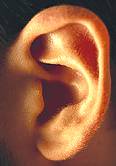 |
 |
 |
||
    |
||||
|
||||

Hispanic Children More Likely to Have Hearing Loss
Second study finds rare eye disease missed, mistreated among urban youngsters|
|
HealthDay
Friday, April 3, 2009
 FRIDAY, April 3 (HealthDay News) -- Children from Hispanic or low-income families are more likely to have hearing loss, and a serious but rare eye disease is often missed or mistreated among urban preschoolers.
FRIDAY, April 3 (HealthDay News) -- Children from Hispanic or low-income families are more likely to have hearing loss, and a serious but rare eye disease is often missed or mistreated among urban preschoolers.
The hearing finding was based on a review of five studies conducted between 1966 and 2007, all of which explored hearing loss among children of various ethnicities from birth through the age of 19.
In contrast, the vision finding was drawn from a new investigation conducted between 2003 and 2007 that looked into so-called "refractive eyesight errors" among black and white children (aged 6 months to about 6 years) living in the Baltimore area.
"Based on the data available in the various studies we looked at, it appears that in the Hispanic population and in low-income homes, there is likely a higher burden of pediatric hearing loss," said Dr. Donald G. Keamy, lead author of the hearing study and a surgeon at the Massachusetts Eye and Ear Infirmary and an instructor in the departments of otology and laryngology at Harvard Medical School.
"But we don't know the absolute cause of that increased rate," Keamy noted. "And it is also very important to point out that the information we looked at is actually both somewhat old and very fractured, in the sense that there is no unified national approach to collecting pediatric hearing loss information. So, we can not even say if the finding is absolutely true until we have a much more systematic and fresh analysis of the problem, which would require a more national approach to the assessment of hearing loss in children."
Keamy published his team's observations in the April issue of Otolaryngology-Head and Neck Surgery. The vision study team, from Johns Hopkins Medical School in Baltimore, reported its findings in the April issue of Ophthalmology.
Keamy and his colleagues point out that hearing loss is one of the most common birth disorders in the United States, noting that two to four of every 1,000 children are born either deaf or hard-of-hearing.
The current review examined prior research gleaned from medical databases and U.S. Centers for Disease Control and Prevention reports.
The hearing study authors found that the average rate of hearing impairment from birth to adolescence was "significantly higher" among all subgroups of Hispanic-Americans (Mexican-American, Cuban-American, and Puerto Rican) and to a similar degree among low-income households.
"The bottom line is that pediatric hearing loss is a largely under-recognized problem that has a great impact on a number of issues, with regard to learning and language development," noted Keamy. "And until we really completely understand the scope of the problem, we can't fix it and make things better."
"So the point here," he stressed, "is that despite the fact that most states now screen newborns for hearing loss before hospital discharge, the process is not entirely standardized, and different techniques are used which have different sensitivities for detecting hearing loss. So the indication about the higher risk among Hispanics is, of course, important. But what we truly hope to accomplish with this work is to encourage the adoption of a more systematic approach to the overall problem."
"This study really shows the need for an apples-to-apples approach to pediatric hearing loss," agreed Robert D. Frisina, an associate chair of otolaryngology at the University of Rochester Medical School in New York.
"This is a relatively novel and interesting analysis," said Frisina. "And I haven't heard of a higher risk among Hispanic households before, which makes it a little bit surprising and provocative. But before any health recommendations could be made, it does need to be followed up to find out with certainty whether or not there is a sampling error here. And to do that, I think a national repository and national standards for hearing loss data collection are very much needed."
As for the vision findings, the Hopkins team -- led by Dr. David Friedman, of the Bloomberg School of Public Health -- found that despite the fact that 5 percent of the nearly 2,300 urban children they examined had a defect in the eye's ability to focus on light that was serious enough to warrant treatment, just 1 percent actually got necessary medical attention.
On the other side of the coin, they actually uncovered some evidence of over-treatment, given that one-third of 29 children who had been prescribed eyeglasses before the study launch actually didn't need them.
HealthDay
Copyright (c) 2009 ScoutNews, LLC. All rights reserved.
Related News:
- More News on Children's Health
- More News on Health Disparities
- More News on Hearing Problems in Children
More News on this Date
Related MedlinePlus Pages:
| Home | Health Topics | Drugs & Supplements | Encyclopedia | Dictionary | News | Directories | Other Resources | |
| Disclaimers | Copyright | Privacy | Accessibility | Quality Guidelines U.S. National Library of Medicine, 8600 Rockville Pike, Bethesda, MD 20894 National Institutes of Health | Department of Health & Human Services |
Date last updated: 06 April 2009 |
